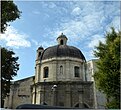This article needs additional citations for verification. (March 2024) |
Sassari
| |
|---|---|
| Comune di Sassari | |
From top left: view of the city; Piazza D'Italia; Rosello fountain; Church of Saint Mary of Bethlehem; Piazza Castello; and Cattedrale di San Nicola | |
| Coordinates: 40°43′30″N 8°33′31″E / 40.72500°N 8.55861°E | |
| Country | Italy |
| Region | Sardinia |
| Province | Sassari (SS) |
| Frazioni |
|
| Government | |
| • Mayor | Giuseppe Mascia |
| Area | |
• Total | 546.08 km2 (210.84 sq mi) |
| Elevation | 225 m (738 ft) |
| Population (31 December 2015)[2] | |
• Total | 127,567 |
| • Density | 230/km2 (610/sq mi) |
| Demonym | Sassaresi or Turritani |
| Time zone | UTC+1 (CET) |
| • Summer (DST) | UTC+2 (CEST) |
| Postal code | 07100 |
| Dialing code | 079 |
| Patron saint | Saint Nicholas |
| Saint day | 6 December |
| Website | Official website |
Sassari (US: /ˈsɑːsəri, ˈsɑːsɑːri/ SAH-sər-ee, SAH-sar-ee;[3][4] Italian: [ˈsassari] ; Sassarese: Sàssari [ˈsasːari]; Sardinian: Tàtari [ˈtataɾi]) is an Italian city and the second-largest of Sardinia in terms of population with 127,525[5] inhabitants, and a Functional Urban Area of about 260,000 inhabitants.[6] One of the oldest cities on the island, it contains a considerable collection of art.
Since its origins at the turn of the 12th century, Sassari has been ruled by the Giudicato of Torres, the Pisans, as an independent republic in alliance with Genoa, by the Aragonese and the Spanish, all of whom have contributed to Sassari's historical and artistic heritage. Sassari is a city rich in art, culture and history, and is well known for its palazzi, the Fountain of the Rosello, and its elegant neoclassical architecture, such as Piazza d'Italia (Italy Square) and the Teatro Civico (Civic Theatre).[7]
As Sardinia's second most populated city, it has a considerable amount of cultural, touristic, commercial and political importance in the island.[8] The city's economy mainly relies on tourism and services, however also partially on research, construction, pharmaceuticals and the petroleum industry.[8]
- ^ "Superficie di Comuni Province e Regioni italiane al 9 ottobre 2011". Italian National Institute of Statistics. Retrieved 16 March 2019.
- ^ "Statistiche demografiche ISTAT". Retrieved 1 January 2017.
- ^ "Sassari". The American Heritage Dictionary of the English Language (5th ed.). HarperCollins. Retrieved 5 May 2019.
- ^ "Sassari". Merriam-Webster.com Dictionary. Merriam-Webster. Retrieved 5 May 2019.
- ^ "Statistiche demografiche ISTAT". Retrieved 1 January 2017.
- ^ "PIB et principaux composants - volumes". Archived from the original on 2015-09-03. Retrieved 2016-09-26.
- ^ "Neoclassical – Artistic – Itineraries – Sardinia Tourism". Sardegnaturismo.it. Retrieved 2011-09-16.
- ^ a b "Sassari – History and culture". Sardegna.net. Retrieved 2011-09-16.










